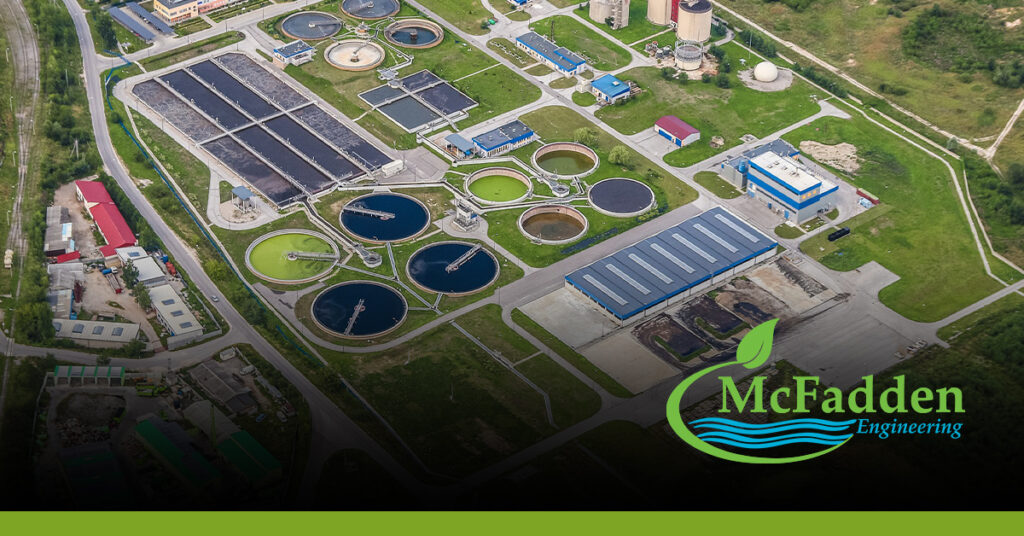Disinfection Options in the Wastewater Engineering Process
September 21, 2022

Chlorine, Ultraviolet and Ozone
McFadden Engineering is known across the Southeast for providing environmentally sound wastewater treatment solutions. Over the last 30 years, a large majority of our projects have included solving wastewater related issues for our clients. Wastewater engineering, also known as sanitary engineering, is the use of treatment processes (biological, mechanical, or chemical) to treat water so that a high-quality water can be achieved and maintained in the effluent. It is a vital component in the protection of public health and the environment.
According to the United States Environmental Protection Agency (EPA), disinfection is the primary mechanism for the destruction of pathogenic organisms. The disinfection process prevents the spread of waterborne diseases to downstream users and the environment. Wastewater disinfection is a vital area within the treatment process because it assists in the prevention of diseases like salmonella, cholera and gastroenteritis. This article takes a deeper dive into various disinfection options with beneficial qualities including chlorine, ultraviolet and ozone.
How is Chlorine Used in the Disinfection Process?
Chlorine (Cl) is the most widespread disinfectant used for municipal wastewater because it destroys target organisms and has a long history of being an effective disinfectant. Chlorination is a commonly used chemical and has a flexible dosing control. There are multiple advantages to using chlorine as a disinfectant including;
- Cost-effectiveness
- Success in eliminating a wide spectrum of pathogenic organisms
- Being useful in oxidizing certain organic and inorganic compounds
- Success in eliminating certain noxious odors during the disinfection process that can cause physical discomfort to residents in adjacent areas
However, care must be taken when using chlorine. Some disadvantages to be mindful of include:
- Toxic gas and extreme corrosion
- Can produce Disinfection By-Products (DBPs) that can cause harm to humans and others living organisms
- Must be handled safely in proper doses
How is Ultraviolet Light Used in the Disinfection Process?
The EPA defines Ultraviolet (UV) disinfection as the transfer of electromagnetic energy from a mercury arc lamp to an organism’s genetic material. Disinfection happens when UV radiation penetrates the cell wall of an organism and destroys the cells’ ability to reproduce.
The benefits of disinfecting with UV radiation include:
- Highly effective in destroying most viruses, spores and cysts without using chemicals.
- No residual effect that can harm human or aquatic life and is a user-friendly operation
- UV radiation is also valuable because it is a physical process that eliminates the need to generate and transport hazardous or corrosive chemicals
Despite being highly effective, there are drawbacks when using UV for disinfection including:
- UV does not leave a residual in the effluent which can allow some of the pathogens to slip through the process in the effluent
- The use of light to decontaminate may render high concentrations of Total Suspended Solids (TSS)
- Pre-treatment efforts need to be vetted prior to the disinfection stage if TSS levels are anticipated to be higher than normal
- Photoreactivation has to be monitored to ensure no micro-organisms are able to repair themselves following the UV light Treatment
How is Ozone used in the Disinfection Process?
For ozone disinfection to occur, ozone (O3) must be produced. The EPA states that ozone is produced when oxygen molecules separate into oxygen atoms. The oxygen atoms collide with an oxygen molecule and form an unstable gas, ozone. Disinfection takes place when ozone decomposes in water and destroys bacteria with the help of hydrogen peroxide and hydroxyl.
Ozone treatment is a more effective option for disinfection than chlorine or UV, however, the capital costs are far greater than other disinfection options making it the least used disinfection method in the United States. Despite the cost disadvantage, there are other advantages to using ozone for disinfection including:
- Generated onsite resulting in fewer problems associated with shipping and handling
- No harmful residuals that need to be removed
- No regrowth of microorganisms, except for the ones protected in the wastewater stream
Similar to the other two options there are cons associated with ozone that include:
- Highly reactive
- Corrosive resistant materials must be used in the application
- Works best in applications where the effluent has been highly treated so that the residual pathogens are attacked and eliminated
Our team at McFadden Engineering has a combined 120 years of experience in solving water and wastewater problems. To learn more about our wastewater treatment projects visit our website or give us a call at 251-470-6870. We are eager to partner with you on your next project.